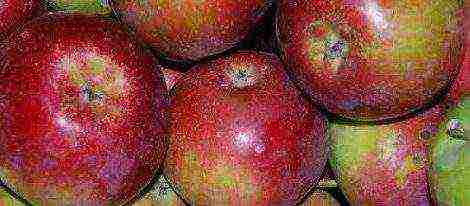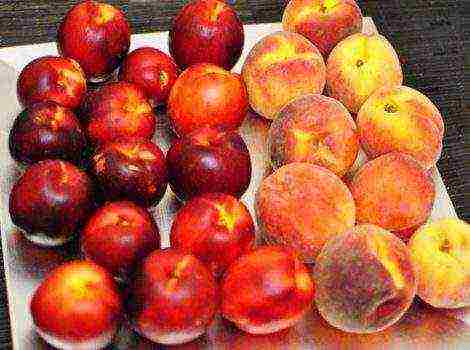Content
Edible honeysuckle is not only a useful plant that can give a rich harvest of delicious berries, but also a bright decoration of the spring garden. Let's see which varieties of honeysuckle should be preferred.
Based on the opinion of experienced gardeners, we have selected the top ten varieties. Although, in terms of decorative qualities, these shrubs can sometimes be inferior to other types and varieties of honeysuckle, but first of all they are famous for their good yield, winter hardiness and unpretentiousness.
In the list, the varieties are located not by popularity (they are all held in high esteem by gardeners), but alphabetically.
1. Altair
This early maturing variety has already managed to fall in love with many gardeners due to its resistance to cold, common diseases and pests. Delicious and sweet berries (blue-blue with a waxy bloom) ripen on a bush with a dense and squat crown in mid-June and do not crumble for a long time. Therefore, Altair is great for people who come to the country no more than once a month. After all, even fully ripe berries remain on the plant until you pick them.
| Bush height (m) |
Ripening period berries |
Fruit weight (g) |
Yield (kg per bush) |
Pollinating varieties |
| Up to 1.4 | June 12-16 | 0,9-1 | 1,7-2 |
Blue spindle Malvina, Morena |
2. Bakchar giant
This large-fruited variety of medium ripening is suitable for those who have enough free space on the site. After all, the powerful bushes of the Bakchar giant reach a height of almost 2 m, and a width of 1.3 m. The crown is oval, spreading, loose. Thanks to the sparse crown, it is convenient to pick fruits from the bush.
Leaves are gray-green, matte. Berries are large (up to 5 cm long), elongated-oval, slightly asymmetrical, dark blue with a waxy bloom. Fruits can be eaten fresh, frozen, and can also be used for making wines, juices, jellies, compotes, and preserves from them.
The plant is winter-hardy, resistant to diseases and pests.
| Bush height (m) |
Ripening period berries |
Fruit weight (g) |
Yield (kg per bush) |
Pollinating varieties |
| 1,7-1,9 | end of June | 1,8-2,5 | 2-3 |
Amphora, Pride of Bakchar, Azure, Nymph, In memory of Gijuk |
3. Blue spindle
This early maturing honeysuckle is distinguished by its high yield, good resistance to frost and drought, as well as to diseases and pests.
The crown of the bush is rather rare, the shoots are thin, straight, greenish in color. Leaves are oval, elongated, dark green. The berries are large (about 2.7 cm long), shaped like an elongated spindle. The skin is blue with a waxy bloom. The flesh is sweet and sour, but can taste bitter during drought. Therefore, when growing this honeysuckle, you must observe the watering regime.
The disadvantage of this variety is that ripe berries quickly crumble.
| Bush height (m) |
Ripening period berries |
Fruit weight (g) |
Yield (kg per bush) |
Pollinating varieties |
| Up to 1 m | June 12-23 | 1-1,5 | 1,5-2,5 |
Cinderella, Kamchadalka, Azure, Bluebird, Tomichka, In Memory of Gidzyuk |
4. Long-fruited
This is one of the first zoned Ural varieties. Long-fruited honeysuckle is characterized by high winter hardiness and early ripening of fruits in the form of an elongated flat cylinder. Their length is up to 2.7 cm. The bush is spreading, with a rounded crown. Shoots are thin, long. Leaves are lanceolate, elongated, dark green.
The skin of the fruit is thin, violet-blue, with a whitish waxy coating. The pulp is sweet and sour, tender, without bitterness. Sprinkling rate of ripe berries is average.
| Bush height (m) |
Ripening period berries |
Fruit weight (g) |
Yield (kg per bush) |
Pollinating varieties |
| Up to 1 m | June 10-20 | 0,9-2 | 1,4-3 |
Zest, Smolinskaya, Sineglazka, Morena, Chernichka. But the best pollinator variety is Chelyabinka |
5. Cinderella
On compact low bushes with a dense crown, thin light green shoots and leaves of the same color, tasty berries ripen in the form of an elongated cylinder or spindle. The skin is thin, dark blue (almost black) with a blue bloom. The pulp is soft, sweet and sour, with a light strawberry aroma, very tasty.
Due to the low growth of the bush, picking berries is difficult, and they also quickly crumble. However, most of the fruits are located on the outside of the crown, therefore, when manually harvesting, it is possible to save the crop.
The variety has a very good winter hardiness, flowers are immune to recurrent spring frosts. In addition, the plant is resistant to disease.
| Bush height (m) |
Ripening period berries |
Fruit weight (g) |
Yield (kg per bush) |
Pollinating varieties |
| 0,6-0,7 | June 15-22 | 0,6-1,4 | 1-3 |
Azure, Gerda, Amphora, Kamchadalka, Leningrad giant, In memory of Gidzyuk, Parabelskaya, Tomichka |
6. Leningrad giant
An adult shrub of this vigorous honeysuckle can reach a height of just over 2 m. It is erect, slightly spreading, with a compact rounded-oval crown. The berries are large (about 3 cm long), as a rule, elongated-cylindrical. They ripen unevenly throughout the month. The berries are arranged in bulky bunches, so they are easy to pick.
The skin is dense, dark blue, with a thin layer of gray waxy bloom. The pulp is dense, fibrous, delicate in taste, sweetish-sour, does not taste bitter.
The variety is resistant to diseases and pests, the plant is not damaged by frost even in severe winters, the flowers can withstand spring frosts down to –7 ° С.
| Bush height (m) |
Ripening period berries |
Fruit weight (g) |
Yield (kg per bush) |
Pollinating varieties |
| 1-2 | June 20 - July 30 | 1-4 | 1-3,3 |
Gzhelka, Blue spindle, Malvina, Morena, In memory of Kuminov, Bluebird, Start |
7. Morena
This early-maturing honeysuckle has a rather wide (up to 1.7 m) and squat crown of an oval shape, lanceolate leaves of a light green color and large fruits (up to 3 cm long) in the form of an elongated jug. They have a thin, almost transparent, blue-blue skin with a pronounced waxy coating. The pulp of the berries is sweet and sour, tender, with a light aroma, without bitterness. Ripe fruits do not fall off the bush for a long time.
The winter hardiness of the variety is above average. The plant is rarely damaged by pests and practically does not get sick.
| Bush height (m) |
Ripening period berries |
Fruit weight (g) |
Yield (kg per bush) |
Pollinating varieties |
| Up to 1.7 | June 15-30 | 1-3 | 1,2-2 |
Viola, Amphora, Blue spindle Kamchadalka, Malvina, In memory of Kuminov, Bluebird, Start |
8. Nymph
The shrub of this variety is medium-sized, with a rounded and slightly spreading crown, prone to thickening. Shoots are long, straight, brownish-green. Leaves are oblong-oval, dark green. The berries are rather large (up to 3 cm long), elongated, resemble a spindle in shape, sometimes they are curved and have bumps on the surface.
The skin is bluish-blue, covered with a waxy bloom of medium intensity. The pulp is fibrous, sweetish-sour, slightly tart, with a spicy aroma and light bitterness. On young plants, ripe berries do not crumble for a long time, and on old ones, ripe fruits quickly end up on the ground.
The variety is very winter hardy, suitable for growing in extreme conditions. The plant is rarely sick.
| Bush height (m) |
Ripening period berries |
Fruit weight (g) |
Yield (kg per bush) |
Pollinating varieties |
| Up to 1.7 | June 13-30 | 1-3 | 1,3-2 |
Amphora, Chosen One, Azure, Pavlovskaya, In memory of Gijuk |
9. Bluebird
This variety is obtained on the basis of Kamchatka honeysuckle.Bushes - vigorous, with a spreading oval crown. Shoots are thin, straight. Leaves are oval, with a pointed tip. Berries are medium (up to 2 cm long), in the form of a slightly elongated ellipse. The skin is bluish-black, with a strong waxy bloom. The pulp is tender, sour-sweet, slightly tart. The fruit tastes like blueberries.
Honeysuckle Blue bird is unpretentious in care, almost does not get sick, does not freeze in winter and is not afraid of harmful insects.
| Bush height (m) |
Ripening period berries |
Fruit weight (g) |
Yield (kg per bush) |
Pollinating varieties |
| 1,3-1,8 | June 14-22 | 0,8-1,2 | 1-2 |
Blue spindle, Cinderella Kamchadalka, Malvina, Morena, In Memory of Kuminov, Titmouse, Start |
10. Tomichka
This plant has a compact, semi-spreading crown, the ends of the shoots falling to the ground. Leaves are light green, slightly pubescent. The berries are shaped like a jug or a wide drop with a depressed top. They have an uneven surface, the skin is blue-violet (almost black) with a waxy coating. The pulp is sweet and sour, without bitterness. The berries are not crumpled during transportation.
In rare cases, the plant can damage aphids.
| Bush height (m) |
Ripening period berries |
Fruit weight (g) |
Yield (kg per bush) |
Pollinating varieties |
| 1,5-1,6 | June 10-20 | 1-2 | 2,5-3,2 |
Blue Spindle, Blue Bird, Pavlovskaya, Bakcharskaya, Vasyugan, Daughter of the Giant, Bakchar giant |
Do you grow edible honeysuckle on the site? If you have not yet decided to "settle" this useful shrub in your garden, read our article 5 reasons to grow honeysuckle in the garden. We hope she will dispel all your doubts!
Honeysuckle unpretentious, hardy, tasty and very useful.
Its only drawback, probably, is that the berries ripen at different times and crumble if they are not picked in time. But it is possible that it will gradually disappear, since many varieties have already appeared for which this is not typical.
And the task of modern breeders is to breed honeysuckle varieties with a very early ripening period, a rich set of biologically active substances and the absence of fruit crumbling.
Honeysuckle varieties
Siberian selection
The most common group of varieties of Siberian selection. Breeders of the Research Institute of Horticulture of Siberia named after MA Lisavenko (Barnaul) and the Bacharsky support point of the Altai Territory developed high-yielding varieties of honeysuckle, resistant to winter temperature fluctuations, in which a large amount of P-active substances were found. The varieties of Siberian honeysuckle are especially good for making jams, compotes, juices, and wine.
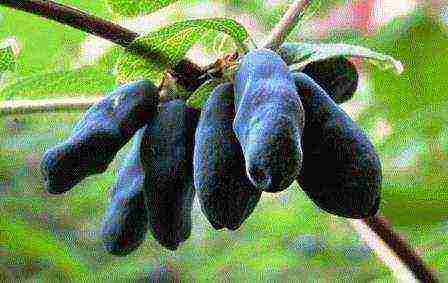 Bakchar giant Bakchar giantThe height of the bush is 1.9 m with an oval crown, the shoots are thick, straight. Fruits are elongated-cylindrical, very large, average berry weight 1.8 g, maximum 2.5 g. Sweet and sour taste. Productivity 2.5-4 kg per bush. The crumbling rate is average. It is not affected by diseases and pests. Purpose - for fresh dessert consumption and processing, transportability is good. |
| Cinderella The bush is dense, 1.3 m high, with a rounded crown. Fruits are round-oval, berry weight 1-1.3 g. Taste is sour-sweet, delicate, with a strawberry aroma, thin skin. Productivity is about 2 kg per bush. The bush is weak, it slowly increases its yield. Sprinkling of berries is average (reviews of summer residents about this vary greatly). Suitable for fresh dessert consumption and processing. |
 Azure AzureThe mass of the berry is 0.7-1.0 g. The taste is sweet and sour with a slight bitterness, the pulp is tender with a blueberry aroma. Productivity is 1-2 kg per bush, there is a secondary flowering in autumn, which affects the yield. The crumbling rate is weak. The appointment is universal. |
 Fire opal Fire opalThe mass of the berry is 0.7-1 g. The taste is sweet and sour with bitterness, a high content of vitamin R. The yield is more than 3-4 kg per bush. Does not crumble. Purpose - technical (including wine), but tasty and fresh. |
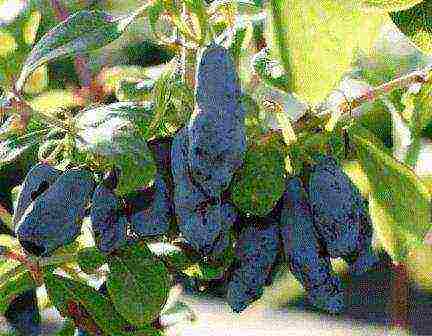 In memory of Gijuk In memory of GijukThe bush is 1.8 m high, densely branched, with a reverse conical crown. Fruits are elongated pear-shaped, berry weight 0.8-1.0 g.The taste is sweet and sour with a slight astringency. Only when fully ripe does it become a little sweeter. Productivity is 2-3 kg per bush. Practically does not crumble. The appointment is universal. |
 Tomichka TomichkaBush 1.5 m high with a rounded crown. Fruits are elongated-elliptical with a roller at the top, berry weight 0.8-1.2 g. Sour-sweet taste with a slight bitterness, thin skin. Productivity is about 2 kg per bush. The crumbling is strong. It is prone to secondary autumn flowering. The appointment is universal. |
Also known are the varieties Berel, Gerda, Goluboe Spindle, Sibiryachka and others.
Leningrad varieties
Received at the Pavlovsk experimental station VIR. They are characterized by a compact, dense crown, dense leaves and sweet berries.
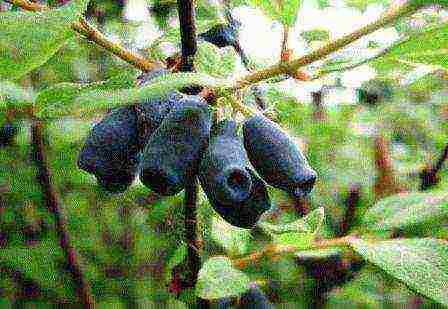 Volkhova VolkhovaThe bush is vigorous, up to 2 m high, with a dense oval crown. Fruits are oblong-oval with a pointed tip. The mass of the berry is 0.6-0.9 g. The taste is sweet with a strawberry hue. Productivity is 1.5-2 kg per bush. The crumbling rate is weak. For fresh dessert consumption and processing. |
 Laura LauraThe mass of the berry is 1.1 g. The taste is sweet, aromatic, the pulp is tender. Productivity is about 2 kg per bush. It falls off when ripe, medium. Good for fresh consumption, as well as for processing .. |
 Lenarola LenarolaThe average weight of the berry is 1.2 g. The taste is sweet and sour, aromatic, the skin is thick. Productivity is about 2 kg per bush. The crumbling rate is average. The appointment is universal. High decorativeness, large flowers, medium resistance to aphids. |
 Nymph NymphBush 1.8 m high, densely branched. Fruits are large, oblong-elliptical and elongated-fusiform, sometimes slightly crooked. The mass of the berry is 1.2 g. The taste is sweet with sourness and pleasant aroma, the skin is dense. Productivity is about 2 kg per bush, in some years there is a secondary flowering. The crumbling rate is low. The appointment is universal. |
Honeysuckle varieties of the Ural selection
Received at the South Ural Research Institute of Horticulture and Potato Growing (Chelyabinsk). The bushes are mostly low (no higher than 1.5 m). Berries often have a tart bitterness. Most varieties are of medium yield, but bear fruit regularly and stably.
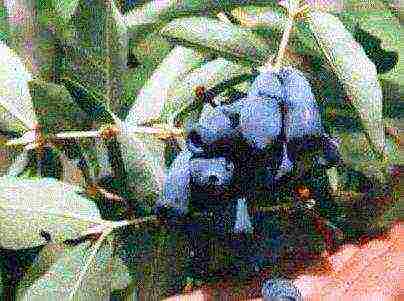 Zest ZestThe bush is compact, 1.2 m high. Fruits are elongated-oval, weighing 0.9 g. The taste is sweet and sour. Productivity 1.2 kg per bush. The shedding rate of fruits is average. |
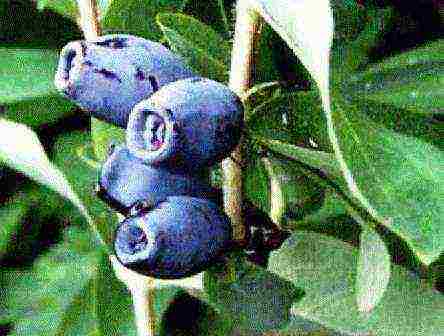 Blueberry BlueberryBush 1.2 m high with a wide reverse conical crown. Fruits are oblong-elliptical with a flat top. The mass of berries is up to 0.8 g. The taste is sweet and sour, the skin is thin, resembling blueberries in shape. The yield is not more than 1 kg per bush, the shedding is average. Fruiting is regular. A variety of universal use. |
The varieties Bazhovskaya, Volshebnitsa, Lazurite are also popular.
Moscow varieties
Grow well in central Russia varieties of Moscow selection, for example, obtained in the Main Botanical Garden of the Russian Academy of Sciences.
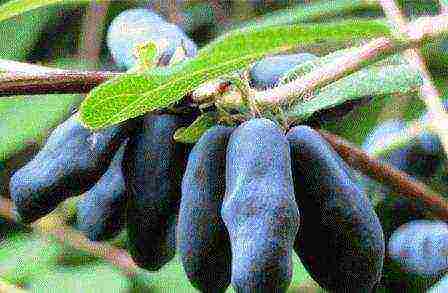 Moskovskaya 23 Moskovskaya 23Densely branched bush, 1.9 m high, with a wide-rounded crown. Fruits are oval-elliptical, weighing 0.8 g. Dessert taste, sweet and sour. Productivity is 3 kg per bush. The shedding rate of fruits is average. |
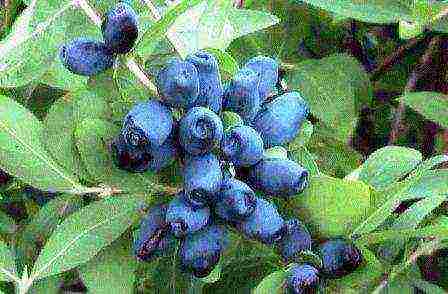 Titmouse TitmouseA bush 2 m high with a spreading-rounded crown. Fruits are elongated-elliptical, weighing 0.9 g. Taste sweet and sour with a refreshing aroma. Productivity 2.5 kg per bush. When ripe, the fruits almost do not crumble. |
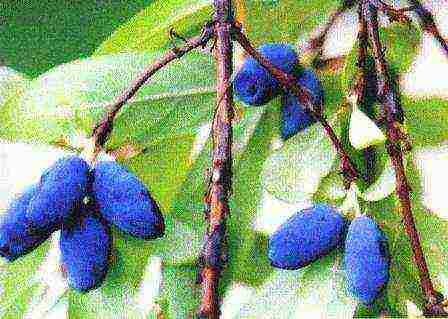 Fortune FortuneThe bush is densely branched, up to 2.5 m high. Fruits are pear-bell-shaped with a roller at the top, weighing 0.9 g. The taste is sweet and sour. Productivity 2.4 kg per bush. Fruit shedding is weak. |
Seaside varieties of edible honeysuckle
Varieties of the Far Eastern Experimental Station of the VNIIR named after N.I. Vavilov (Vladivostok) often ripen at an early date and are prone to shedding. It is better not to use these varieties (Dolphin, Golubinka, Rassvet, Zarnitsa and others) for central Russia because of the frequent secondary flowering (in the case of warm autumn), which leads to a decrease in yield and a weakening of the plant.
According to the description of characteristics
For convenience, we present a list of honeysuckle varieties according to the main characteristics:
SWEET VARIETIES: Altair, Amphora, Dessert, Gourmet, Nymph, Pavlovskaya, Slavyanka, Bullfinch, Souvenir.
HARVEST VARIETIES: Berel, Blue Spindle, Cinderella, Long-fruited, Ivushka, Kapel, Katyusha, Morena, Moskovskaya, Narymskaya, Fire Opal, Salute, Selena, Sibiryachka, Titmouse, Sirius, Violet.
EARLY VARIETIES: Berel, Viola, Sorceress, Blue spindle, Long-fruited, Cinderella, Morena, Sineglazka, Blue bird, Tomichka.
VARIETIES WITH LARGE FRUITS (weighing 1 g and above): Bazhovskaya, Sorceress, Long-fruited, Cinderella, Chosen One, Raisin, Lapis Lazuli, Swan, Lenita, Morena, Narymskaya, Nymph, Omega, Pavlovskaya, Sineglazka, Sibiryachka, Violet.
VARIETIES RESISTANT TO FRUIT SHALLOWING: Borel, Raisin, Azure, Fire Opal, Omega, Nightingale, Roxana.
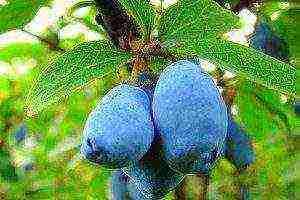
Honeysuckle, being originally a wild shrub, in its modern "cultivated" form, is now becoming an increasingly popular plant among professional and amateur gardeners.
In this regard, summer residents are wondering which varieties of edible honeysuckle are optimal for growing in domestic conditions.
Here we will try to concisely describe the best popular representatives of this berry culture, which are sold in plant stores and nurseries, and also explain how to care for them.
Good to know: garden plant honeysuckle
- the most winter-hardy crop grown on a personal plot. In winter, plants tolerate severe cold without damage (from -45 to -47 ° C)
"Gzhelka"
The "Gzhelka" variety is ready to ripen a little later than others, but it has good resistance to late frosts during sap flow and flowering.
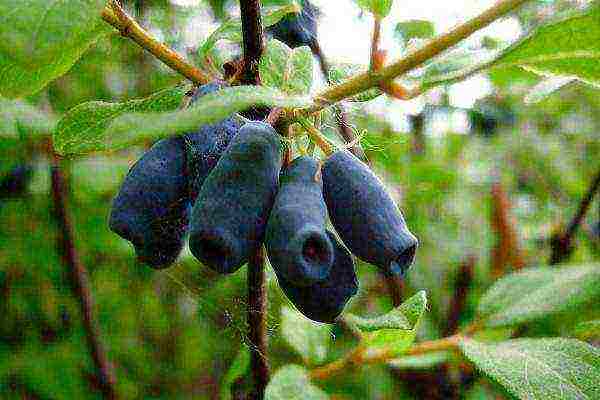
When growing this variety in an open space, bushes can grow up to two meters in height. In the case of their close location to each other, they can be small, but no less productive.
Fruits are characterized by moderate sweetness with typical tartness. With proper care, the yield can be up to 2.5 kilograms of berries.
"Gzhelka" is also suitable as a decorative garden decoration. Large leaves of a dark green hue are optimal for organizing hedges (you can read a description of the types of decorative honeysuckle here).
"Gzhelka", one might say, is a universal variety, as it can be actively used in the landscape design of the site in front of the house, and collect amazing sweet berries, useful vitamins and microelements.
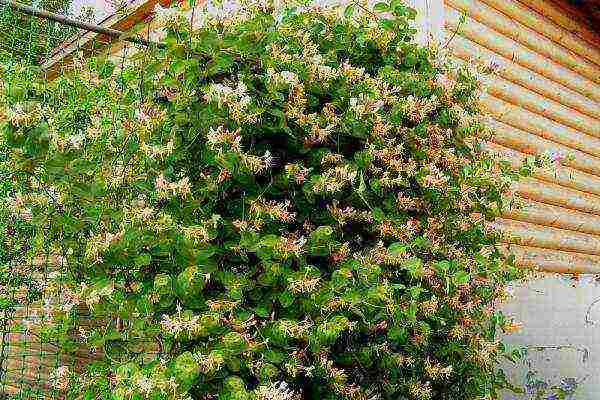
Honeysuckle in landscape design
"Cinderella"
This is an early-ripening variety that starts bearing fruit within the second year after planting. Prefers proximity to the "Leningrad Giant" and "Amphora".
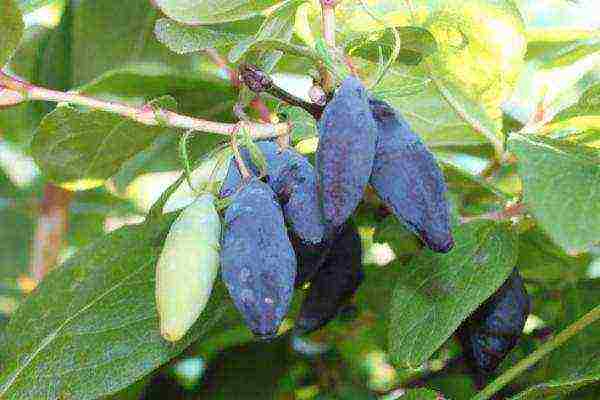
The bush is most often small - about a meter. Fruits are medium-sized with a bluish bloom and thin skin. Berries have a sweetish taste with sourness and strawberry aroma. The yield is approximately 1.5 - 3 kg per bush.
Note: The Russian climate is best suited for the growth of honeysuckle. In milder climates, it is quite difficult to obtain large yields of this berry crop.
"Moraine"
The variety is a representative of the Pavlovsk breeding station family. It can ripen within a week depending on the region. Berries can remain on the branches for a long time and not fall off.

Shrubs are medium-sized with a spreading crown and green leaves. Fruits with a fragrant odor, with a sweetish tart taste without the aftertaste of bitterness.
Berries "Morena" are large enough - up to three centimeters, which greatly facilitates the harvest. The yield of berries is average - about 1.5 kilograms.
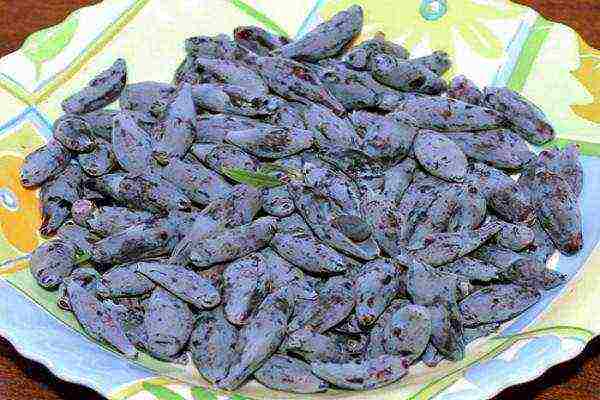
"Blue bird"
The Blue Bird is a relative of the wild Kamchatka honeysuckle. The selection was carried out at the Siberian Research Institute. This is an early ripe variety, rather unpretentious in care and has good resistance to diseases and pests of honeysuckle.
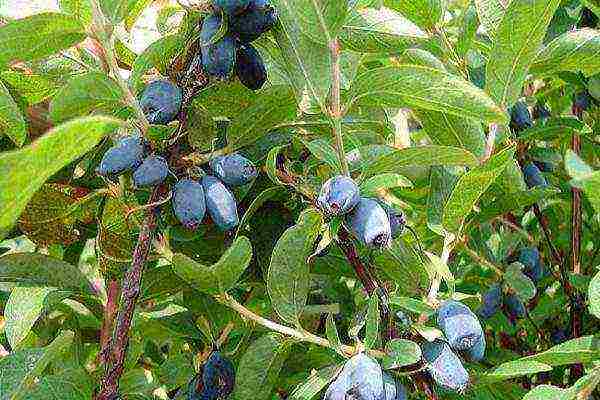
The crop appears after a three-year period from the moment of planting. Bears fruit for a long time - within 20-25 years. It is characterized by a spherical crown shape, the bush is quite massive.
The berries are elongated in blue-blue color with a waxy bloom characteristic of honeysuckle. The taste is very soft without sourness, the yield is large enough - about 1.5 - 2.5 kilograms.

Note: the variety is picky about the place of growth - it grows well in sunny, windless areas with well-moistened soil.
"Amphora"
The name of the variety comes from the Kamchatka wild-growing honeysuckle, and is applicable for cultivation in cool regions of the Russian Federation. This is a plant with an average fruit ripening period. The bushes are small (maximum 1.5 meters), the crown is rounded. Prefers neighborhood with "Morena", "Altair", "Gzhelka".
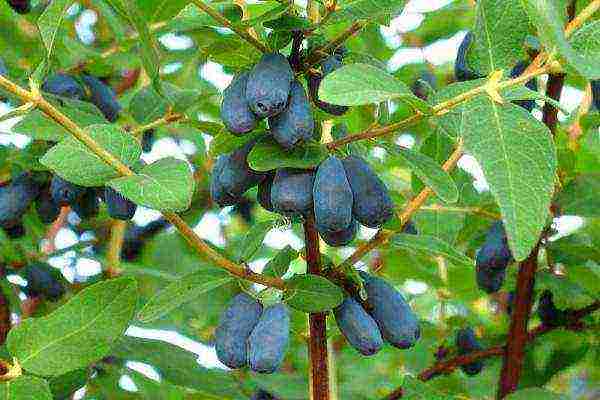
Fruiting occurs after a three-year growth period. The berries are large, their length can be up to 2.2 centimeters. They grow in an aesthetic jug-like shape and are covered with a thin skin. Sweet and sour on the palate with a slight bitterness at the end.
This is a great option for blanks for the winter. The yield is about a kilogram per bush.
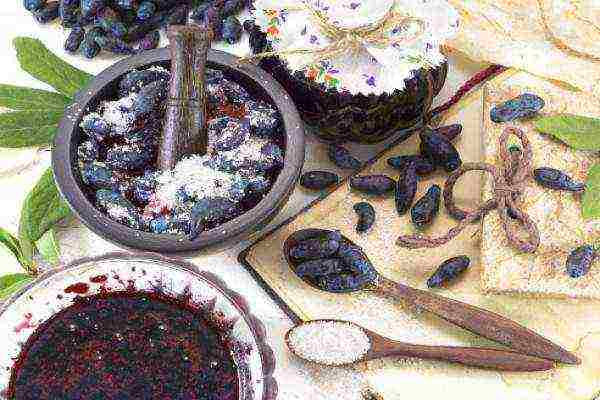
Honeysuckle compote and jam - a good preparation for the winter
Altair
Honeysuckle of the early ripening period from the Pavlovsk selection family. It comes from wild-growing Kamchatka counterparts, therefore it has a fairly high resistance to pests and diseases.
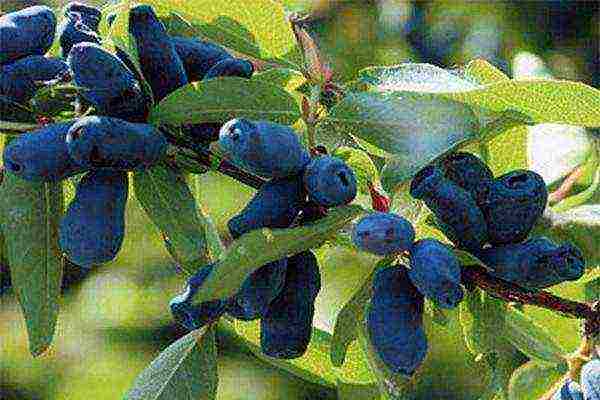
In the central regions of Russia, berries ripen one week later than other varieties. The bushes can reach up to 1.5 meters in height, and have a squat crown in the shape of a ball. The berries are medium in size with a strong bloom.
According to gardeners, Altair is one of the best varieties. Its fruits are distinguished by sweetness, juiciness, but there is also astringency in the taste. Harvest up to 2.5 kilograms per bush.
"Dolphin"
Dolphin is one of the representatives of the seaside selection of honeysuckle. Most of all, it is adapted for growing in the eastern regions of the country. Ripening period is average. Flowering occurs at least twice a season - in spring and autumn, because winter hardiness is quite low.
The shrub can grow up to one and a half meters in length. Its crown is densely growing, rounded. Shoots slope to the ground, leaves are wide, concave.
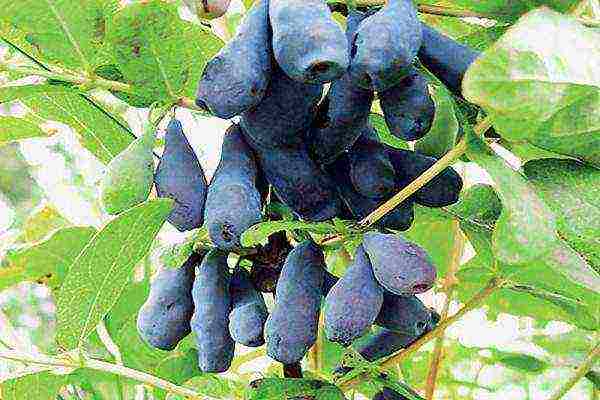
The berries are quite large, in the shape of a cylinder, their upper part can be associated with a dolphin's smile - this explains the etymology of the variety.
The fruits are lumpy, the skin is thick enough. The berries are not very large, but there are many of them. The yield is about three kilograms.
Gardeners for a note: foreign varieties were not mentioned here, which are also worth paying attention to, since these are unique hybrid plants. For example, George Bugnet's honeysuckle, Marie Bugnet (Canada), whose berries ripen from June to August and do not crumble for a long time. Amur (Germany) and Blue-Gray (USA) have elongated berries with an amazing taste and a complete lack of bitterness.
Honeysuckle is a fairly early maturing and early-growing culture. Only garden strawberries and raspberries can compete with it in these parameters.
From this video You will learn about the most popular varieties of honeysuckle:
Rate the article
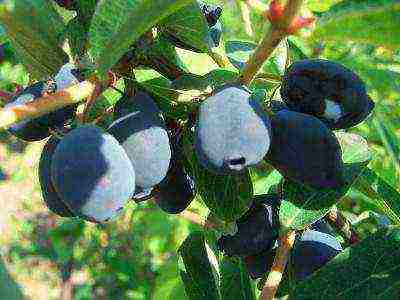 Every year the earliest berry is becoming more popular - edible honeysuckle. Breeders are making honeysuckle varieties more and more attractive to gardeners. Emphasis is placed on important consumer properties: the size of the fruits, their taste, an increase in yield and a decrease in shedding.
Every year the earliest berry is becoming more popular - edible honeysuckle. Breeders are making honeysuckle varieties more and more attractive to gardeners. Emphasis is placed on important consumer properties: the size of the fruits, their taste, an increase in yield and a decrease in shedding.
Brief description of culture
Honeysuckle came to our gardens from the Far East. Here it grows in floodplain forests, on the outskirts of bogs, in river valleys. Wild honeysuckle berries are slightly bitter. But the best cultivated varieties of edible honeysuckle can boast not only sweetness and variety of tastes, but also different aromas.You can grow fruits that have a slight sourness or bitterness, opt for completely sweet berries. There are even varieties with a strawberry flavor.
The flavor and appearance of berries is often compared to blueberries. But the fruits of honeysuckle are not only tasty, they are very healthy. Vitamins and flavonoids, antioxidants and antibacterial substances make berries a tasty and useful prevention of ailments.
Honeysuckle bushes start growing early in spring. It blooms in the first days of May, and in the first days of summer it already treats us with fruits, ahead of the earliest varieties of garden strawberries. Among the descriptions of edible honeysuckle varieties, you can find later varieties that allow you to extend the period of consumption.
The most popular varieties of honeysuckle
Cinderella
The dark, almost black berries of this early variety, covered with a gray bloom, surprise with a mild strawberry scent. The industrious honeysuckle Cinderella begins to bear fruit early. The harvest of berries can be obtained already in the second year after planting.
Cinderella is distinguished by a significant yield, giving 3 kg from a low bush (0.7-1.2 m). The berries crumble a little. The plant almost never gets sick, tolerates frost well. Most varieties of honeysuckle are better pollinated and set more fruit when adjacent to other varieties. For Cinderella, the desired neighbors will be the Leningrad giant, Titmouse, Amphora, Roxana.
Moraine
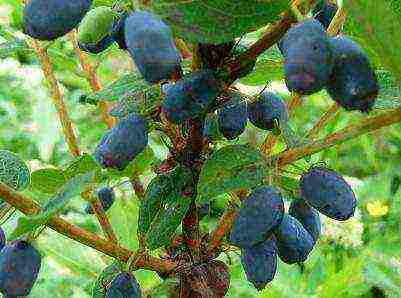 Ripens very early. Perhaps this honeysuckle is the best among the early varieties: its fruits ripen a week earlier than most other early ripening varieties; berries are able to stay on the bush for a long time without crumbling.
Ripens very early. Perhaps this honeysuckle is the best among the early varieties: its fruits ripen a week earlier than most other early ripening varieties; berries are able to stay on the bush for a long time without crumbling.
Large, long (up to 3 cm) berries are easy and pleasant to pick off. Their taste is tart-sweet, there is no bitterness. The fragrant and juicy berries with a thin skin are so tasty that even the low yield of this variety can be forgiven. For better pollination of Morena's honeysuckle, its proximity to Viola, Nymph, Amphora, Blue Spindle is desirable.
Kamchadalka
 Beautiful and fruitful. The cold-resistant representative of the Siberian selection belongs to the varieties of medium ripening terms. Large berries of a weakly pointed shape grow on a high one and a half meter bush. The length of delicate fruits with a thin skin is up to 2.7 cm. The berries do not crumble.
Beautiful and fruitful. The cold-resistant representative of the Siberian selection belongs to the varieties of medium ripening terms. Large berries of a weakly pointed shape grow on a high one and a half meter bush. The length of delicate fruits with a thin skin is up to 2.7 cm. The berries do not crumble.
The variety grows well in temperate climates, tolerates temperature extremes well. It also pleases with its yield, reaching 3.5 kg. For pollination of this variety of honeysuckle, Cinderella, Parabel, Tomichka, Blue Spindle are recommended. The graceful conical shape of the crown and the elongated leaves with clear outlines make it also a good decoration for the garden landscape.
Leningrad giant
 Tall bushes of this variety (over 1.5 m) begin to delight with ripe fruits from the end of June. Fruiting is stretched out in time, berries can be harvested throughout July. They are able to hang for a long time without crumbling. More than 3 kg are removed from the bush. massive fruits. Harvesting is easy as the berries are arranged in large bunches.
Tall bushes of this variety (over 1.5 m) begin to delight with ripe fruits from the end of June. Fruiting is stretched out in time, berries can be harvested throughout July. They are able to hang for a long time without crumbling. More than 3 kg are removed from the bush. massive fruits. Harvesting is easy as the berries are arranged in large bunches.
In order for the variety to be able to fully manifest itself, it is necessary to plant a Blue Bird, Blue Spindle, Morena or Gzhelka with it. The Leningrad giant is considered one of the best varieties for medicinal purposes, making jam and compotes. He also holds the record for winter hardiness. The beautiful oval crown of a shrub with bright foliage allows it to be used to decorate the site.
Amphora
 On medium-sized bushes (1.2-1.5 m.) Purple fruits with a whitish bloom grow. They have a characteristic jug-like shape and large size, reaching 2.5 cm in length. The berries covered with a dense skin are good in maturation, they are excellently transported. Since shedding is completely unusual for fruits, they are harvested in one go. All these qualities make it possible to classify Amphora as one of the best varieties of honeysuckle for commercial use. Well transported.
On medium-sized bushes (1.2-1.5 m.) Purple fruits with a whitish bloom grow. They have a characteristic jug-like shape and large size, reaching 2.5 cm in length. The berries covered with a dense skin are good in maturation, they are excellently transported. Since shedding is completely unusual for fruits, they are harvested in one go. All these qualities make it possible to classify Amphora as one of the best varieties of honeysuckle for commercial use. Well transported.
Regular fruiting of Amphora begins from the third year of cultivation. It is well pollinated with Bazhovsky honeysuckle, Morena, Altair.Frosts Amphora tolerates well and is recommended for the northern regions of Russia.
Blue spindle
 Unpretentious variety. This classic variety of edible honeysuckle perfectly tolerates frosts, including Siberian ones, does not suffer from spring returns of cold weather, and is highly resistant to diseases. Stable fruiting of the Blue Spindle variety begins from the 4th year of cultivation. The yield increases annually, reaching 3 kg. But to increase it, it is necessary to have Morena, Kamchadalka, Tomichka or Blue Bird in the garden.
Unpretentious variety. This classic variety of edible honeysuckle perfectly tolerates frosts, including Siberian ones, does not suffer from spring returns of cold weather, and is highly resistant to diseases. Stable fruiting of the Blue Spindle variety begins from the 4th year of cultivation. The yield increases annually, reaching 3 kg. But to increase it, it is necessary to have Morena, Kamchadalka, Tomichka or Blue Bird in the garden.
Attracts the Blue Spindle with large fragrant berries. Their slight bitterness resembles that of wild strawberries. The processed variety is very tasty. Of the shortcomings, shedding of fruits is noted, therefore, when the ripening period begins, it is advisable to spread fabric, paper or any covering material under the bushes.
Pavlovskaya
 Another classic variety. He was one of the first, characterized by the minimum shedding of berries. Although the variety has average yields (1.5-2 kg per bush), it bears fruit regularly and the berries ripen together. Their taste is sweet, dessert, sourness is almost imperceptible. The size of the berry is up to 1.6-1.8 cm.
Another classic variety. He was one of the first, characterized by the minimum shedding of berries. Although the variety has average yields (1.5-2 kg per bush), it bears fruit regularly and the berries ripen together. Their taste is sweet, dessert, sourness is almost imperceptible. The size of the berry is up to 1.6-1.8 cm.
The variety is winter-hardy and self-fertile. For normal fruiting, joint planting with Tomichka, Vasyugan, Blue Spindle, Blue Bird is necessary.
Blueberry
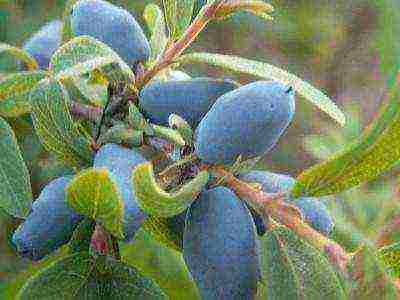 It is easy to guess from the name which flavoring note prevails in this variety of honeysuckle. The excellent sweet and sour taste of aromatic berries is good for both fresh berries and processed ones. Elongated berries are covered with a thin skin. They are not very large, rarely reaching 1.7 cm.
It is easy to guess from the name which flavoring note prevails in this variety of honeysuckle. The excellent sweet and sour taste of aromatic berries is good for both fresh berries and processed ones. Elongated berries are covered with a thin skin. They are not very large, rarely reaching 1.7 cm.
Medium-sized bushes have a spreading crown. Their fruiting period begins at 4 years of age. Perhaps this honeysuckle is the best in terms of yield: up to 5 kg can be harvested from an adult bush. The variety is classified as medium-late, cold-resistant, unpretentious. Fruit shedding is insignificant.
Features of growing honeysuckle
Its wild ancestors grow in wet forest areas. Hence, we can conclude that honeysuckle will feel most comfortable in conditions of sufficient moisture. When planting it in your area, consider the possibility of regular watering.
Although the plant needs good enough light, constant exposure to the sun depress the honeysuckle bushes. The best place to plant a plantation will be an area where it will be slightly shaded by tree crowns at noon.
In order for the pollination of flowers to take place as efficiently as possible, it is necessary to plant several varieties in the garden. The more varietal variety, the better. Planting fragrant flowers also helps attract beneficial insects.
